

 |
 |
On September 23rd I simply fancied a local photo shoot. The waxing moon would soon be setting in the late evening and with dark skies, Milky Way, and planets Jupiter and Saturn on show it was an opportunity not to be missed. I had the cameras already charged and hit the back roads of Co. Tyrone with the intention of trying out a new location. During the Summer Roisin and I had been passing through the wonderful countryside here when Roisin had spotted a unique looking tree, this was no ordinary tree, it looked special and had all the hall marks of a fairy tree, its cool shape and the fact that it was on its own in a field with no other trees for company made it stand out and with a flat horizon all around it made for great foreground interest for nightscapes. I'm always on the look out for foreground which would compliment the night sky, nowadays I find myself looking for more of a simple scene with as little clutter as possible so the images tend to be more dramatic. Trees are usually in groups, or if you do find a good one there's a hill, house or power lines ruining the potential or else the only compass point which works is either S or E.
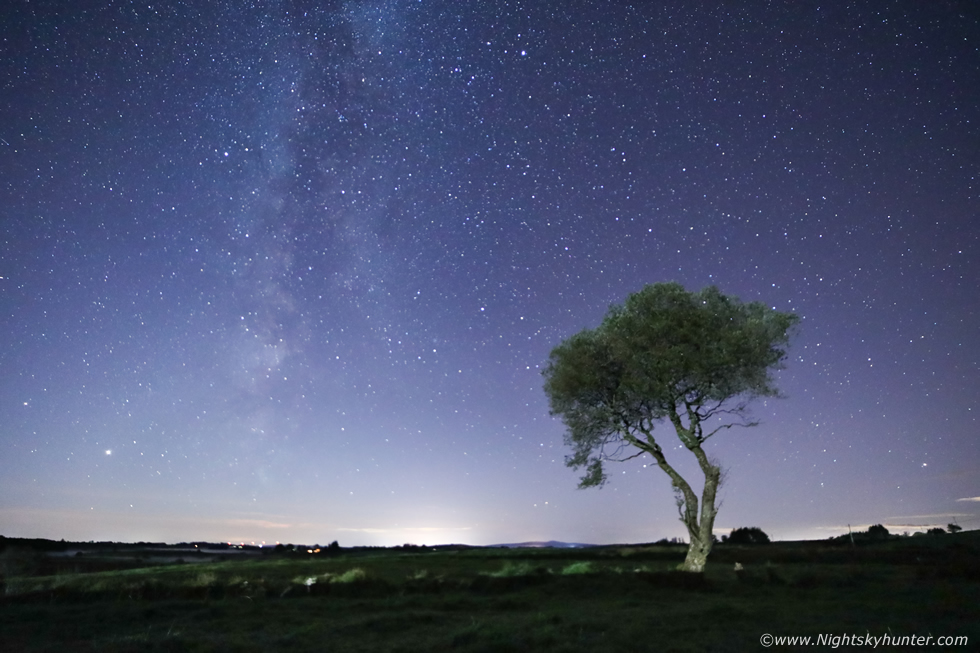 |
This tree was exceptional as it was isolated and dominated the Co. Tyrone landscape just begging to be photographed with the stars. I had only captured it at night once before during mid Summer with comet C/2020 F3 NEOWISE over its canopy, it was then that I realized just how perfect this location was for future shoots because a casual examination of the site indicated it could work with the N, NW, W, SW and NE sky sectors so the tree could be used for conjunctions, Milky Way, aurora, star trails, meteor showers, pretty much anything I wanted to catch with the N being prime location. As I drove along the road I watched the moon set then the sky grew rapidly dark, I parked the van at the side of the road, gathered my gear and stepped outside into the calm cool night. I did a quick sweep of the field to make sure there where no Cattle present, it looked vacant and safe, then I switched off my head torch and made my way into the field letting my eyes adjust to the dark.
It didn't take me long getting a composition which I liked with the tree in the rule of thirds and Milky Way and planets in a similar position. At first I spent some time taking stills, for these I was using the Canon 5D Mark IV with the Irix 15mm F/2.4 Blackstone lens. I had stopped the aperture down to F/2.8 and used 13-15 second exposures at ISO 6400, I may even have used ISO 8000 for a few. The exposure exaggerated the distant glow of light pollution on the horizon from distant towns however this didn't affect the overall impact of the image in the slightest. Jupiter is the bright star to the lower left and further left of that is Saturn, both planets were currently in a nice conjunction in the evening sky located near Sagittarius in proximity to the Milky Way. The Milky Way itself looked impressive visually and on camera with vivid gas clouds, dark lanes, and obscurations as the two steamers of our galaxy completely dominated the W sky all the way to the horizon.
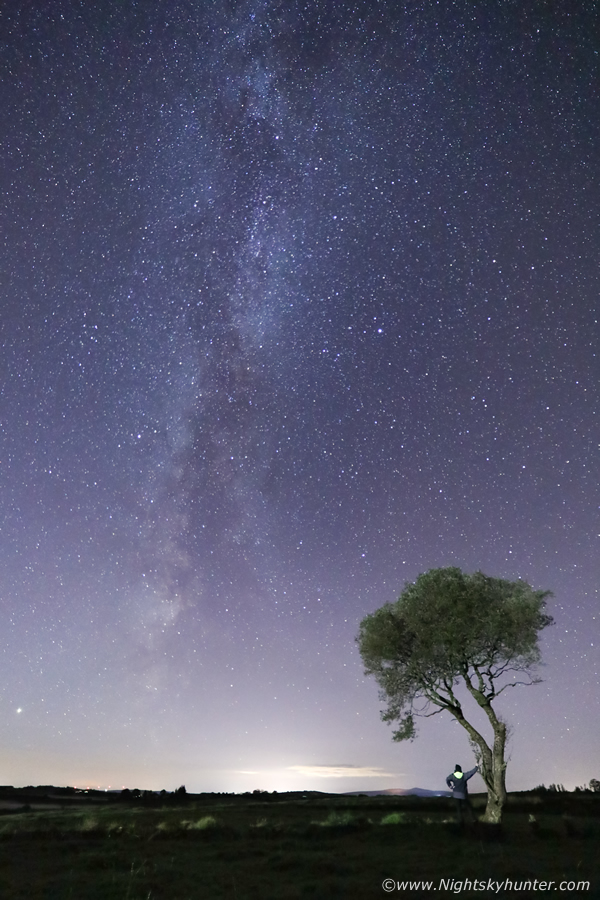 |
You won't often see me take portrait images but in this case a vertical aspect was essential for showcasing the full extent of the Milky Way. I framed this scene, set the camera on continuous shooting, then walked into the scene to try out selection of selfie poses, I liked this one with me leaning on the old tree, the 5D and Irix where doing me proud this night. Once I got images I was happy with I began shooting a star trail/time lapse here with the 5D then using the 600D with 10mm F/2.8 Samyang I began shooting a second trail with the tree, this time with the camera facing N. I then let the cameras do their thing and backed off into the centre of the field and blended in with the grass, closed my eyes, did controlled deep breathing exercises to oxygenate my brain and eyes then after 20 minutes I had obtained full dark adaption. It was clear from the onset that this was a night of exceptional quality, one of only two amazing skies this year. The seeing was good and the transparency was excellent with not a cloud in the sky and it looked like there was no jet stream aloft at all, it was like the Earth had no atmosphere and I was witnessing the skie's purity, these nights are very rare indeed.
I did the best 'dome search' I have done in years, I systematically scanned the entire sky all around me through all compass points and from zenith to the horizon going over all the constellations and star positions I knew. It's amazing how certain faint stars and home grown asterisms I had created years ago still remained fresh in my mind. Some of these patterns were designed to learn clusters of stars to check for Novae and yet others symbolized sorrowful memories such as the death of my Granny and Benson my Dalmatian Dog. I went over every single star I knew since 1997 and made sure everything was as it should be, I made a note of the magnitude of the famous naked eye variables such as Algol, Mira, Delta Cephei, Chi Cygni, TCrB and RCrB, Eta Aquilae and others. I definitely could see stars below magnitude +6, but how faint I wasn't certain as I would have needed to check an atlas when I got home, however I would safely say naked eye stars to mag +6.3 to +6.5 in certain regions of Cygnus.
I could see the North America Nebula and Pelican Nebula easily with dark division between the two attractions and of course the dust clouds within the Milky Way were vivid, the most striking of which was M24 The Great Sagittarius Star Cloud which was so dense it looked like a lump of colourless cloud which never drifted away. Looking to the SE and high up was the large faint fuzzy patch of M33, always a good sign when this galaxy can be discerned and the farthest naked eye object you can see (further than M31). M31 itself was splendid and extended further in horizontal extent that usual thanks to the great sky, it was a massive object, many people don't realize that on CCD images the galaxy is actually 5 degrees wide. Planet Mars was a gorgeous sight as a vibrant orange star among the faint stars of Pisces. When we face SE during the late evening at this time of year we are looking away from the plane of our galaxy and out into deep space, the constellations here are less dense with stars and lay along the ecliptic plane or Zodiac. Located between Pisces and Aries in a blank region of sky was the infamous Gegenschein as an elongated oval haze barely visible against the background sky and extending from this oval was a segment of the Zodiacal Band. These are faint large scale delicate forms which require good skies away from lights and trained averted vision to see. People think that the best skies are pitch black, or at least black to some degree, but true great skies are actually not, when you are away from lights and the transparency is at the top of the scale and your dark adaption is advanced (stay away from phones and camera screens) you will notice that the sky is actually bright and seems to have a glow or charged look about it, this is not only ambient light but sky glow too.
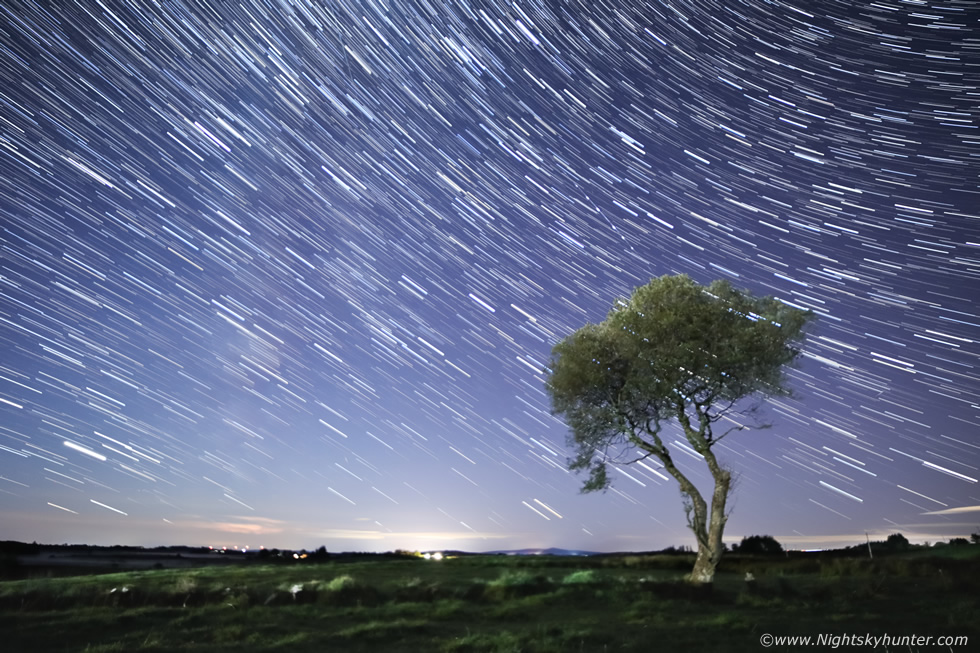 |
My observing had distracted me from the physical discomfort of the night and as I snapped out of my starry day dreams I realized I had been standing absolutely still in this field for a long period of time. A shiver ran down my spine and my breath condensed in the chilly air, the field was damp with dew and there wasn't a breath of wind, the temperature had dropped to +2C and I will admit that I was chilled to the bone, by standing so still I had allowed my body temperature to drop which was not a good idea. I made my way back to the van then warmed up inside with a snack and stayed there for a good 45 minutes then went back outside into the field to check the cameras. I suspected I likely had a fantastic time lapse of the Milky Way setting with the fairy tree. When I previewed the images I was annoyed to see that at least 50% of the images on both cameras were ruined by the lens misting over with dew, in fact, both cameras were drenched. I was able to salvage enough frames for a short time lapse and star trail but to be honest I was far from disappointed as I knew I had good stills taken from earlier and it was these which had made my night, this was the star trail from the 5D.
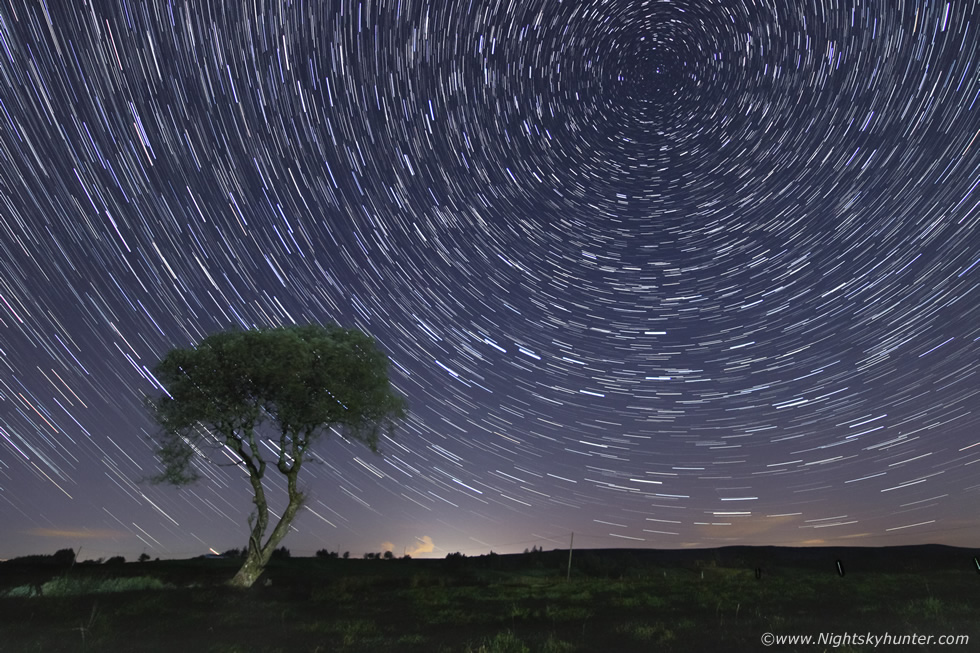 |
600D (crop sensor) star trail facing N, this turned out very nice indeed. The first aurora of the season had been captured at this time from the north coast however I couldn't see a hint of aurora here, as it turned out the aurora was very low on the horizon and faint, however in the future I intend on catching a major aurora over this tree.
 |
Before packing up I wiped the lens on the 5D and took a few more exposures, this was the other end of the field where a random tree posed for me once again. I would have loved to have stayed out longer for a better time lapse but after three hours here in the damp and cold I decided to call it a night when the going was good and was back indoors for 02.00 BST. The next day when I checked the images I was shocked to see that the Irix lens had messed up on me during the shoot. At the start of the night the stars were points of light however later the stars became blobs which made the above image look out of focus somewhat. I guessed at the time it was likely dew forming and dismissed it until I did a daylight test at infinity and noticed that even distant trees were soft. My expensive Irix lens was now not focusing on infinity at all and I had a major problem. I didn't have the focus lock on that night however even so I've never had a manual focus lens shift focus like that on any night shoot before, and even so it was still not working the next day, I did a little research and read that this lens can be calibrated, or more specifically the focus ring could be re-calibrated. When I first got the lens the infinity mark was never at infinity, in fact, it was to the left of this at the F/11 mark on the housing. This was close, to be honest the stars were never pin points even then but when viewed wide open it wasn't noticeable so I let it go, but now it was so far out the lens was useless, I decided that I needed to try a re-calibration myself before contacting the company.
The next day I called into Home Base and purchased a set of magnetic micro tipped screwdrivers, I watched a few youtube tutorials then had my first go at adjusting the manual focus ring. It was fidgety work and the screws were tiny, thank goodness for the magnets as I'm certain I would have lost the screws without them, several times a screw fell inside the internal mechanism and I thought it was game over and each time I managed to get them out again. Moving the internal ring involved lateral movement and pushing using the screw driver, this was not great as I scored the inside metal and the screw heads looked like they were getting threaded, I'm no surgeon and my patience was going but I managed to get the ring moved, I tested focus on a distant tree, it was better but not perfect, I tightened everything up and decided I would test it later, I needed the stars out and as luck would have it we had arranged another photo shoot this very night.
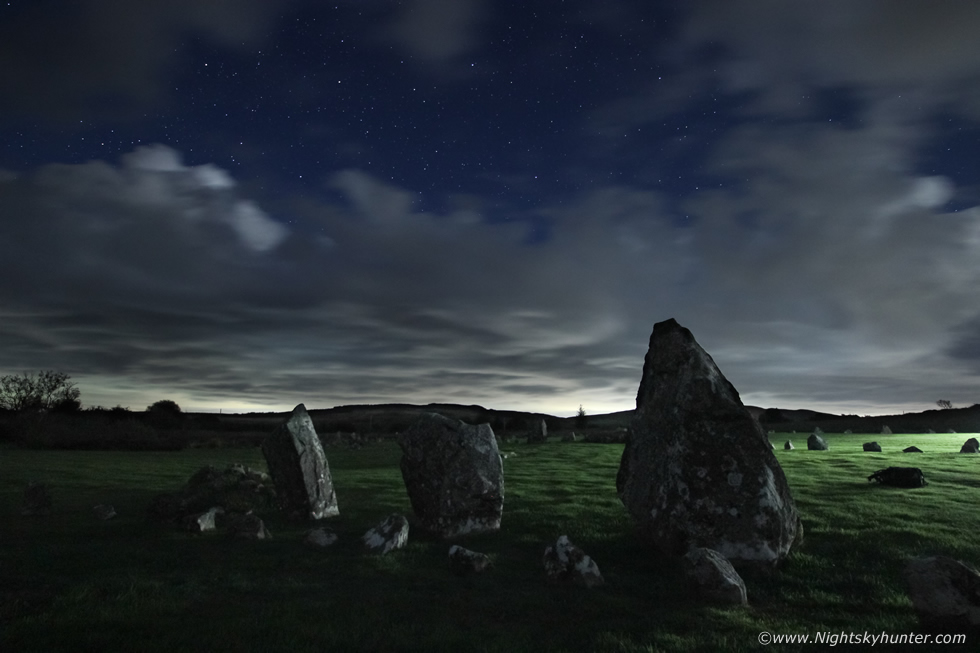 |
On September 24th John Fagan and I had arranged a local shoot, with a promise of good clear skies we decided to meet at Beaghmore Stone Circles. At sunset a spent thunderstorm had sent a great cloudscape inland in the form of a dramatic shelf cloud lit by beautiful sunset colours, I managed to get drone imagery when it was at its finest before the sun slipped below the horizon. I headed out the road soon after and arrived at Beaghmore then John arrived soon after. I did a test with the 5D and Irix, in an instant it was obvious the lens was still out of focus, the stars were blobs and the focus ring couldn't travel any further to the left so it looked like I would have to re-do the calibration again another time, so my full frame was out of action this night so I went back to my old faithful 600D and 10mm lens, I would miss the clean high ISO ability and of course the large sensor but my crop sensor had served me well for years so I got back into that mind set once more. I spent some time among the stone circles taking test exposures, these are moonlit clouds from decaying convective showers with stars. John and I were going to shoot a time lapse here until moonset however several others had arrived into the grounds and were shining lights on all the stones so we knew a lapse wasn't going to happen tonight, after a chat we decided to move to another location.
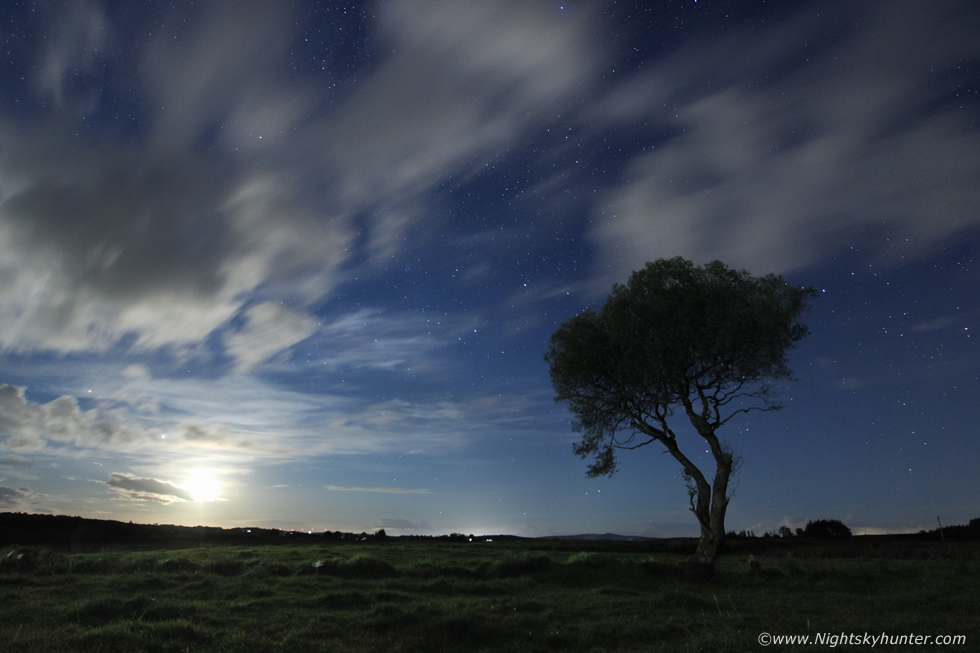 |
We moved on to Roisin's fairy tree which brought us much needed peace with no one else around, this was John's first time at this location and he loved it as much as I did. We began shooting a time lapse, the glow is from the waxing moon with Jupiter and Saturn, or plan was to get a time lapse movie of these setting then another lapse of the Milky Way, however the Met Office forecast was once again dodgy and we had more cloud than clear spells. A shower approached us from behind and we spotted a respectable moonbow to the N, John and I looked at each other, should we stop the time lapse and shoot the moonbow?, a lunar rainbow with this tree would be stunning, however we remained committed as our time lapse was under way and let it go, perhaps another time. Then it completely clouded over with rain and our long clear night quickly ended and we had to go home.
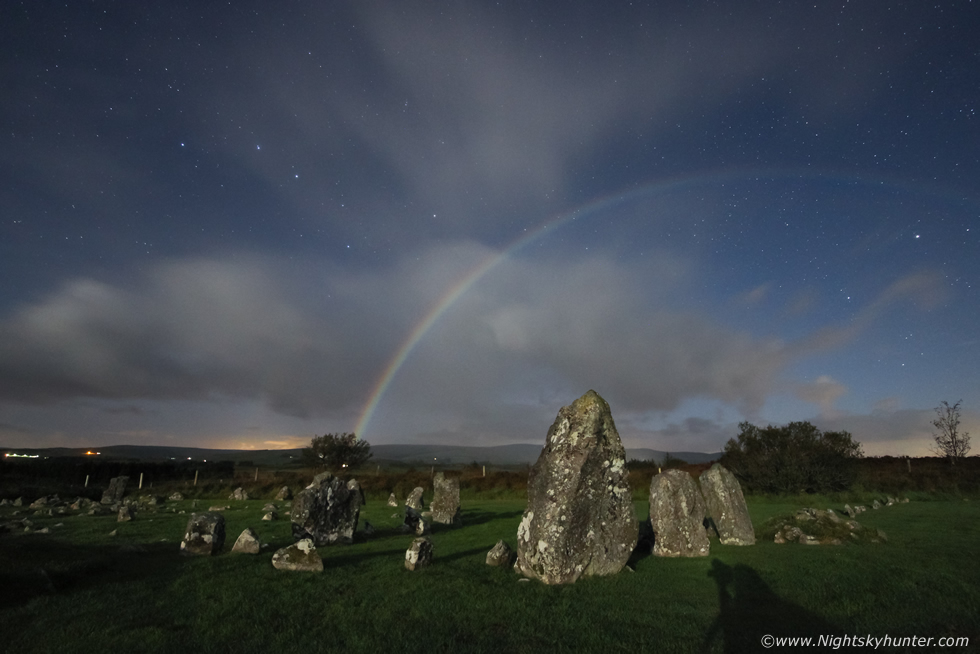 |
Clear skies were forecast for the third night in a row so this time John Fagan and I met up with Paul Martin for another shoot. No showers were forecast at all and the night was expected to be clear, dry and cold with a NWly breeze so we all decided to shoot the fairy tree together. Our meeting point was Beaghmore Stone Circles once again, this time I arrived a little early, I was still lamenting the Irix lens and was frustrated at the thought of shooting tonight with the crop sensor again, so to pass the time until the guys arrived I reluctantly walked among the seven large stone circles. The night was clear and the moon was between first quarter and waxing gibbous and low in the S, I noticed moonlight was casting long shadows of the stones across the grass so I began taking a few test images. Then in what seemed like an instant, a ghostly arc of light formed in the sky to the N, the light was curved and I could see blue and red-orange colours with the naked eye, this was a moonbow or lunar rainbow. I couldn't believe my luck, I have been observing and shooting moonbows since 2008 and over the years I have captured some vivid unforgettable specimens, some of these I have captured during dedicated moonbow hunts and yet other times the captures have been accidental, but in all cases I never had any great foreground to go with the bows, I usually got them over fields or beaches, but now I realized what was being presented before me so I reacted fast and began taking exposures before it vanished.
Never before have I captured a moonbow over an ancient megalithic site, especially one so famous as Beaghmore Stone Circles, the colourful primary rainbow arced over the standing stones as it passed across Ursa Major, Lynx and Auriga, there was even a faint secondary moonbow. Moonbows can vanish within seconds so you don't have a lot of time to work on compositions and mess about with settings, so I just began rapidly shooting exposures making sure the bow and the stones where in the frame together, I reckon I perhaps got seven or eight good exposures, I was using ISO1600 with shutter speeds between 18 and 20 seconds with the 10mm lens wide open at F/2.8 using auto white balance.
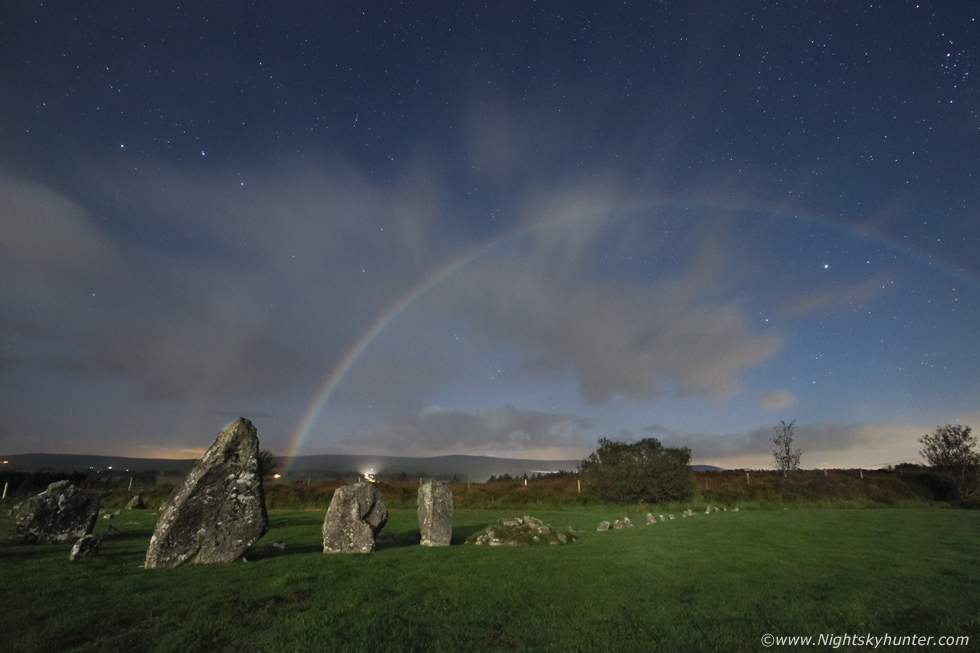 |
I stepped back and quickly re-framed the scene with the stones at the rule of thirds and took another exposure. If you have hunted moonbows before then you will appreciate how difficult it can be to capture a photogenic bow as many tend to be associated with cloud and such bows don't work well on camera. The best moonbows always happen when clear skies and stars can be seen during the same time as the moonbow is present, these situations can happen during cold air mass showers behind fronts or simply from an isolated shower dissipitating. Any decent wind can blow precip droplets down range ahead of the cloud also offering a photogenic bow against the stars, but most important of all is moon phase and height. A bright moon will generate a bright moonbow, but at the same time a brighter background sky means less contrast between sky and bow and there will be less stars present, I believe stars need to be visible in the image so the viewer will know immediately that they are in fact seeing a moonbow.
The moon also needs to be lower than 42 degrees in height, if higher then there will be no moonbow at all, this planning can be useful so make a note of the moon's elevation in the sky at a given time and of course the time of year as the angle of the ecliptic to the horizon varies each season. In my opinion moon phases after first quarter then two days from full and again after full are the best times for moonbow hunting, however fainter bows can be captured on camera at first quarter phase or less, there's some world wide competition on who can catch a moonbow with the weakest moon phase, if you check out my moonbow article you can learn more about the basic ingredients required for a successful moonbow hunt.
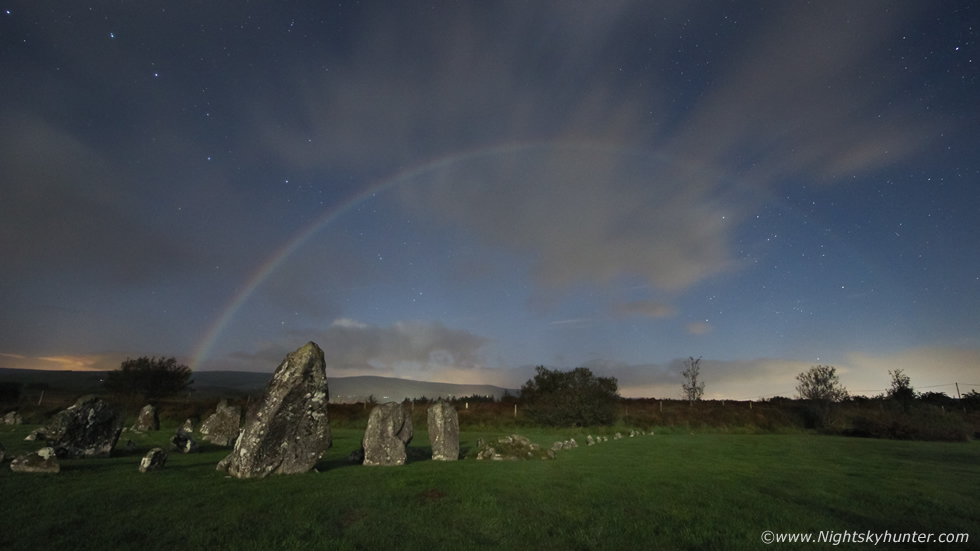 |
This site pre-dates Christ and has a lot of history, I often wonder what the ancient people who lived and worshipped here witnessed in the skies here. They must have seen great auroras and meteor events, moonbows, and perhaps several striking comet apparitions, I wonder what they made of it all. I heard Paul Martin and John Fagan arrive in the car park then within a minute the bow had vanished, I have to say this five minute moonbow had completely made my night.
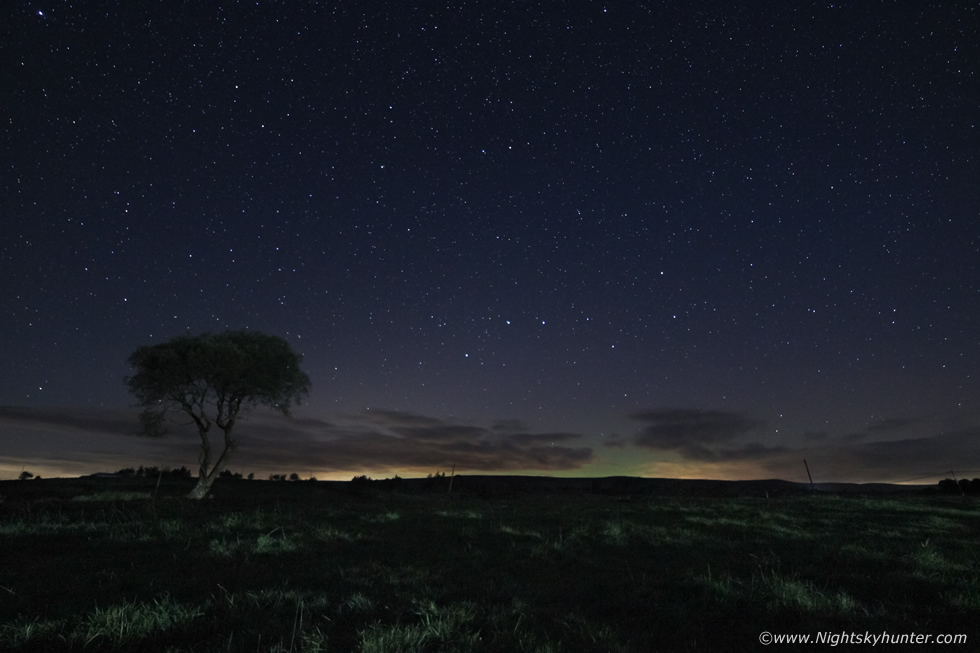 |
Paul, John and I spent the night with the fairy tree, we shot star trails and time lapse and had a great chat. It was bitterly cold, yet again damp dew was forming on the lenses and the wet air and damp grass sucked all warmth from our bodies and even though I was wearing thermal gear I was still cold. All three of us jumped on the spot and did shadow boxing, it was a humorous sight if someone had seen us through a night vision scope. Another aurora appeared, the second display within three days thanks to a weak solar wind stream from a coronal hole. Paul had picked it up on camera earlier in the night however it wasn't until after moonset that we could confirm it visually as an enhancement to the sky, it was mostly colourless but at times I could discern a subtle green tone which showed up well in this 28 second exposure. We are currently making our first steps towards the next solar maximum predicted for 2025 and already the sun has been slowly getting more active with short lived new sunspot groups and regular coronal holes. Given time we will be witnessing an increase in sunspot activity with associated solar flares and CME events which will generate serious aurora activity, I can't wait for those nights to return. I really enjoyed these three nights of local shooting and hope to get back out soon for more astrophotography, thanks very much for reading.
Martin McKenna